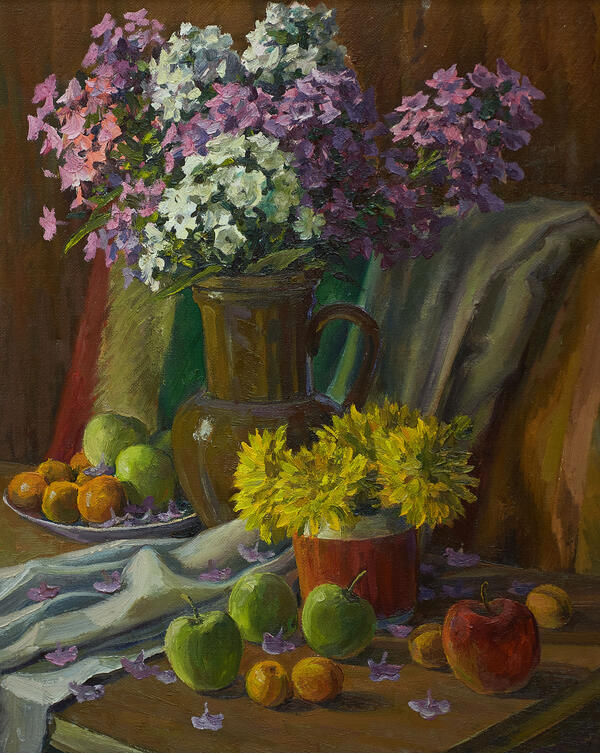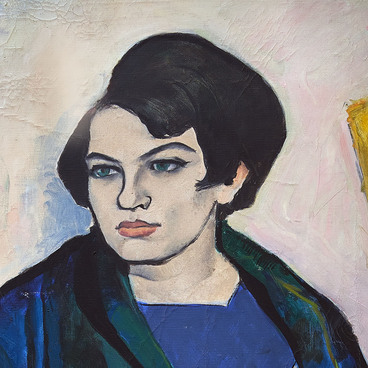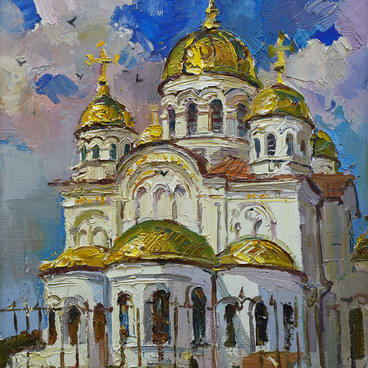‘Still life with Phloxes’, which is in the collection of the Valuy Museum of History and Art, was created by the artist Boris Fedorov.
The painter was born on September 23, 1948 in Rylsk, Kursk region. After studying at a secondary school, he graduated from the faculty of drawing and painting at the Krupskaya Moscow National University of Arts by correspondence. Then, Fedorov returned to the Belgorodchina and began to live in Valuyki. He spent many years working at the Municipal Education Institution Secondary School No. 2 in Valuyki as a design artist, and later in the Valuy House of Crafts as a master.
Boris Fedorov is a multiple participant of regional and international exhibitions. In 1986, he participated in the group exhibition ‘Artists of Belgorod’ in Opol (Poland). Also, the artist often organized personal and participated in joint exhibitions at the Valuy Museum of History and Art: one of the last took place on September 25, 2018 and was timed to the 70th anniversary of the author.
Artist Boris Fedorov works in the field of lyrical landscape and still life. Each of his works is the result of a thoughtful and careful study of homeland nature. His works are imbued with love and touching attitude to the places where he grew up.
The painting ‘Still life with Phlox’ shows fragrant flowers that are surrounded by summer fruits. They are located on a wooden table, on which colorful draperies fall. Green and blue fabrics from a cold range in the background emphasize the warm shades that Fedorov used in coloring flowers.
The artist depicted two bouquets opposite in size and color, so they are in separate vessels. A bouquet of white and purple Phloxes in a ceramic jug rises above the entire composition and is its center. The whole table is strewn with purple dots of fallen Phlox inflorescences.
Fyodorov’s picture is full of bright colors, and looking at it, you can not leave any small detail or any leaf without attention. But, despite the richness of the color palette, the author focuses on the floral composition. The artist’s goal was to transfer his admiration for the natural beauty and plant diversity of his native land to his canvas. He conveyed a positive mood from viewing this canvas to the audience.
The painter was born on September 23, 1948 in Rylsk, Kursk region. After studying at a secondary school, he graduated from the faculty of drawing and painting at the Krupskaya Moscow National University of Arts by correspondence. Then, Fedorov returned to the Belgorodchina and began to live in Valuyki. He spent many years working at the Municipal Education Institution Secondary School No. 2 in Valuyki as a design artist, and later in the Valuy House of Crafts as a master.
Boris Fedorov is a multiple participant of regional and international exhibitions. In 1986, he participated in the group exhibition ‘Artists of Belgorod’ in Opol (Poland). Also, the artist often organized personal and participated in joint exhibitions at the Valuy Museum of History and Art: one of the last took place on September 25, 2018 and was timed to the 70th anniversary of the author.
Artist Boris Fedorov works in the field of lyrical landscape and still life. Each of his works is the result of a thoughtful and careful study of homeland nature. His works are imbued with love and touching attitude to the places where he grew up.
The painting ‘Still life with Phlox’ shows fragrant flowers that are surrounded by summer fruits. They are located on a wooden table, on which colorful draperies fall. Green and blue fabrics from a cold range in the background emphasize the warm shades that Fedorov used in coloring flowers.
The artist depicted two bouquets opposite in size and color, so they are in separate vessels. A bouquet of white and purple Phloxes in a ceramic jug rises above the entire composition and is its center. The whole table is strewn with purple dots of fallen Phlox inflorescences.
Fyodorov’s picture is full of bright colors, and looking at it, you can not leave any small detail or any leaf without attention. But, despite the richness of the color palette, the author focuses on the floral composition. The artist’s goal was to transfer his admiration for the natural beauty and plant diversity of his native land to his canvas. He conveyed a positive mood from viewing this canvas to the audience.



